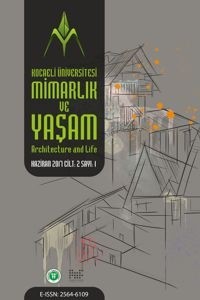Sekanslar Yoluyla Mekânsal Bütünlük: Mimari Tasarım İçin Çağdaş Senaryo Planlama Teknikleri
Senaryo Tabanlı Tasarım, Mimari Senaryo, Kullanıcı Merkezli Tasarım, Tasarım Metodolojisi
Spatial Integrity Through Sequences: Contemporary Scenario Planning Techniques for Architectural Design
___
- Arora, V., Putcha, S. (2014). Scenarios for Sustainable Supply Chains: A Case for Chemical Industry (1st ed.). LAP LAMBERT Academic Publishing. https://www.perlego.com/book/3351307/scenarios-for-sustainable-supply-chains-a-case-for-chemical-industry-using-scenario-planning-as-a-tool-for-long-range-decisions-pdf,52–71.
- Bernstein, C. (1996). Experiments. Boundary 2, 23(3), 67–72. https://doi.org/10.2307/303638
- Brook, P. (1968). “The Empty Space.” New York: Atheneum, 111-112.
- Brown, A.G.P. (2001). Architectural critique through digital scenario-building. In: de Vries, B., van Leeuwen, J., Achten, H. (eds) Computer Aided Architectural Design Futures 2001. Springer, Dordrecht. https://doi.org/10.1007/978-94-010-0868-6_52, 8-14.
- Buday, R. (2017). The Art of Architectural Storytelling, or How to Present a Building. Common Edge., 1-9.
- Bürger, P., Shaw, M., Schulte-Sasse, J. (2016). Theory of the avant-garde. University of Minnesota Press., 14-27.
- Calvino, I. (1979). “Invisible Cities.” Translated by William Weaver. London: Pan, 15-17.
- Carroll J. M. (1999). Five reasons for scenario-based design. Proceedings of the 32nd Hawaii International Conference on System Sciences – 1999, Maui, HI, USA. DOI: https://doi.org/10.1109/ HICSS.1999.772890.,4-11.
- Haynes, S., Purao, S., Skattebo, A. (2009). Scenario-Based Methods for Evaluating Collaborative Systems. Computer Supported Cooperative Work. 18. 331-356. 10.1007/s10606-009-9095-x.
- Carroll, J.M., (1995). Scenario-Based Design: Envisioning Work and Technology in System Development. John Wiley & Sons, New York., 7-10.
- Chermack, T. (2011). Scenario Planning in Organizations. Berrett-Koehler Publishers. https://www.perlego.com/book/1249055/scenario-planning-in-organizations-how-to-create-use-and-assess-scenarios-pdf, 1-288.
- Clark, R., Mayer, R. (2012). Scenario-based e-Learning (1st ed.). Wiley. https://www.perlego.com/book/1000128/scenariobased-elearning-evidencebased-guidelines-for-online-workforce-learning-pdf, 36-65.
- Eilouti, B. (2018). Scenario-Based Design: New Applications in Metamorphic Architecture. 7. 530-543. 10.1016/j.foar.2018.07.003., 530-543.
- Esraz-Ul-Zannat, Md. (2014). A GIS based Approach (1st ed.). LAP LAMBERT Academic Publishing. https://www.perlego.com/book/3378196/a-gis-based-approach-vulnerability-assessment-damage-quantification-in-the-light-of-climate-change-induced-flood-scenario-pdf, 1-140.
- Frey, J. N. (1994). How to write a damn good novel. St. Martin's Press, 101-103.
- Gupta, H., Singh, L. (2012). Rural Energy Scenario In India (1st ed.). LAP LAMBERT Academic Publishing. https://www.perlego.com/book/3354892/rural-energy-scenario-in-india-energy-use-pattern-of-different-fuels-in-india-and-their-impacts-on-sustainable-development-for-the-country-pdf, 1-60.
- Harvey, D. (1973). Social Processes and Spatial Form: (1) The Conceptual Problems of Urban Planning. In Social Justice and the City (REV-Revised, pp. 22–49). University of Georgia Press. http://www.jstor.org/stable/j.ctt46nm9v.4
- Harvey, D. (1973). Urbanism and the City—An Interpretive Essay. In Social Justice and the City (REV-Revised, University of Georgia Press. http://www.jstor.org/stable/j.ctt46nm9v.9 195–284.
- Hoa, N. T. (2015). How to develop a low carbon scenario for a country?A study in Vietnam (1st ed.). LAP LAMBERT Academic Publishing. https://www.perlego.com/book/3429838/how-to-develop-a-low-carbon-scenario-for-a-countrya-study-in-vietnam-pdf, 1–172.
- Kahane, A. (2012). Transformative Scenario Planning (1st ed.). Berrett-Koehler Publishers. https://www.perlego.com/book/1248450/transformative-scenario-planning-working-together-to-change-the-future-pdf, 1-31.
- Libeskind, D. (2004). Breaking Ground: Adventures in Life and Architecture. John Murray, London, 221-222.
- Lyu, F. (2019). Architecture as spatial storytelling: Mediating human knowledge of the world, humans and architecture. Frontiers of Architectural Research. 8. 10.1016/j.foar.2019.05.002. 275-283.
- McKay, M. (2011). The cambridge introduction to the novel. Cambridge University Press. 11-35.
- Mamun, Md. M.A., Islam, Md. N., Mondol, Md. S. (2012). The Renewable Energy Scenario in Bangladesh Perspectives (1st ed.). LAP LAMBERT Academic Publishing. https://www.perlego.com/book/3357159/the-renewable-energy-scenario-in-bangladesh-perspectives-barriers-for-sustainability-of-the-alternative-energy-technologies-pdf, 1–88.
- Martelli, A. (2014). Models of Scenario Building and Planning. https://doi.org/10.1057/9781137293503 Mitchell, W. (2003). Me++: The Cyborg Self and the Networked City. Cambridge, Mass.: MIT Press, 8-11.
- Pattazhy, S. (2018). Future Scenario of Communication towers and Impacts on Wildlife (1st ed.). LAP LAMBERT Academic Publishing. https://www.perlego.com/book/3432041/future-scenario-of-communication-towers-and-impacts-on-wildlife-pdf, 1-96.
- Psarra, S. (2009). Architecture and Narrative: The Formation of Space and Cultural Meaning (1st ed.). Routledge. https://doi.org/10.4324/9780203639672, 241.
- Rabiger, M. (2017). Developing story ideas: The power and purpose of storytelling. Routledge, 120-122.
- Ruijter, P.D. (2014). Scenario Based Strategy: Navigate the Future (1st ed.). Routledge. https://doi.org/10.4324/9781315607689, 1-200.
- Schoemaker, P. (2022). Advanced Introduction to Scenario Planning. Edward Elgar Publishing. https://www.perlego.com/book/3546452/advanced-introduction-to-scenario-planning-pdf,152-190.
- Simeone, D., Toldo, I., Cursi, S. (2014). Operational Scenarios Simulation to Support Building Design: A Hospital Design Case Study. In: Hodicky, J. (eds) Modelling and Simulation for Autonomous Systems. MESAS 2014. Lecture Notes in Computer Science, vol 8906. Springer, Cham. https://doi.org/10.1007/978-3-319-13823-7_12, 1-14.
- Snyder, B. (2005). Save the cat!: The last book on screenwriting you'll ever need. Michael Wiese Productions, 46-47.
- Truby, J. (2008). The anatomy of story: 22 steps to becoming a master storyteller. Faber & Faber, 40-41.
- Tupe, N. (2013). Scenario Based Learning (1st ed.). LAP LAMBERT Academic Publishing. https://www.perlego.com/book/3341182/scenario-based-learning-a-better-methodology-of-teaching-english-and-mathematics-pdf ,1-156.
- Van der Linden, V., Dong, H., Heylighen, A. (2019). Populating architectural design: Introducing scenario-based design in residential care projects. International Journal of Design. 13, 21-36.
- Vesely, D. (2004). Architecture in the Age of Divided Representation: The Question of Creativity in the Shadow of Production. The MIT Press, Cambridge and London., 24-36.
- Whorf, B. L. (1956). “Language, Thought, and Reality.” Edited by John B. Carroll. Cambridge, Massachusetts: The M.I.T. Press, 1-278.
- Wigley, M., Graham, J., Allais, L. (2015). 2000+ The urgencies of architectural theory: A symposium. GSAPP Books, 210-235.
- Wright, G., Cairns, G. (2011). Scenario Thinking. Palgrave Macmillan UK. https://www.perlego.com/book/3498311/scenario-thinking-practical-approaches-to-the-future-pdf, 1-30.
- Zheng. (2014). Scenario Monitoring (1st ed.). LAP LAMBERT Academic Publishing. https://www.perlego.com/book/3374926/scenario-monitoring-how-should-indicators-be-found-for-scenario-monitoring-pdf ,1-100.
- ISSN: 2564-6109
- Başlangıç: 2016
- Yayıncı: Kocaeli Üniversitesi
Van Kent Yapı Stokunun Mimari Özellikleri ve Mühendislik Uygulamaları Üzerine Bir Değerlendirme
Osmanlı İmparatorluğu’ndaki Demiryolu Seferberliğinin Konya Vilayeti Üzerindeki Kentsel Etkileri
Ekolojik Binaların Sürdürülebilir Tasarım Kriterleri ve Değerlendirme Süreci
Ahmet Necip BELEK, Ruşen YAMAÇLI
Biyomimetrik Yapı Malzemeleri ile Post Pandemik Döneme Uygun İç Mekanlar Tasarlanması
Yüzen Evlerde Sürdürülebilirlik Kavramı
Filiz TAVŞAN, Sümeyye PERVANOĞLU, Cengiz TAVŞAN
Dolgu Duvarlı Çerçevelerde Sıvanın Deprem Davranışına Katkısı
Safranbolu Eski Çarşı Bölgesinde Mekanın Tüketim Ekseninde İrdelenmesi
Sebile Merve ÖZTÜRK, Ruşen YAMAÇLI
Sekanslar Yoluyla Mekânsal Bütünlük: Mimari Tasarım İçin Çağdaş Senaryo Planlama Teknikleri
İç Mimarlık Eğitiminde Sanal Gerçeklik Uygulamalarının Önemi
